Ibike Korea People-to-People Program
 Photo essay:
Gyeongbokgung
Walking Tour
Photo essay:
Gyeongbokgung
Walking Tour
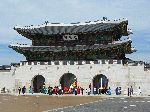
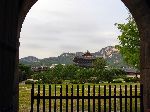 Gyeongbokgung,
built in 1395, was the primary palace of the
Joseon Dynasty. While it has a resemblance to the Forbidden City in
Beijing, much of it has been destroyed. It was never as large as
the Forbidden City because Korea was generally subservient to China and had to
show deference. This is Gwanghwamun (gate) and the palace wall.
Gyeongbokgung,
built in 1395, was the primary palace of the
Joseon Dynasty. While it has a resemblance to the Forbidden City in
Beijing, much of it has been destroyed. It was never as large as
the Forbidden City because Korea was generally subservient to China and had to
show deference. This is Gwanghwamun (gate) and the palace wall.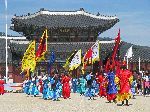
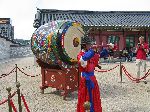
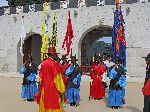 During the day, weather permitting, there are
ceremonies for the opening and closing of the palace gates, and twelve, hourly Changing-of- the-Gate-Guards, with several variations.
During the day, weather permitting, there are
ceremonies for the opening and closing of the palace gates, and twelve, hourly Changing-of- the-Gate-Guards, with several variations.
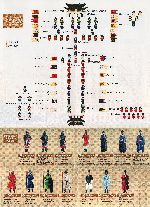 When
the guards are in position they are happy to stoically pose for pictures with
the tourists -- individuals or groups. There is no one keeping order for
this process so if there are a lot of tourists it can be very competitive to be
the next person saddled up to the guard for the photo-op.
When
the guards are in position they are happy to stoically pose for pictures with
the tourists -- individuals or groups. There is no one keeping order for
this process so if there are a lot of tourists it can be very competitive to be
the next person saddled up to the guard for the photo-op.
The chart (right) shows the various ranks and their respective uniforms and positioning in ceremonies. The ceremony was first fully established in 1469. The ceremony reenacted today has been revived in accord uniforms, weaponry and formalities customary in the early Joseon, in the 15th century.
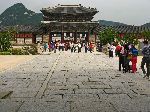
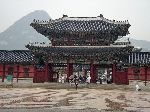
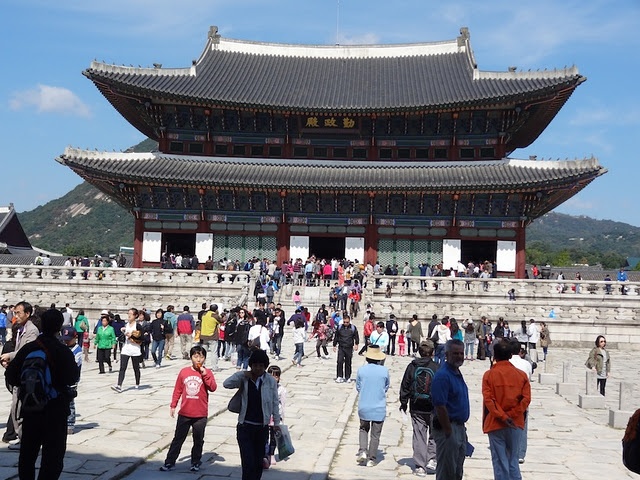
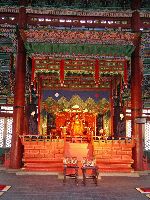 Geunjeongjeon, considered the
greatest building of Joseon architecture. It is the main building of
Gyeongbokgung. It is the place where ceremonies of the state, such as new
year's greetings to the king by civil and military officials, were held, and
where foreign envoys were received. It is believed to be in a very
auspicious location; surrounded by four mountains and with a stream running
through the grounds. Behind
the throne (right) is a picture showing a red sun and a white moon, above five
mountains, a waterfall and the ocean (the realm) and pine trees (a sacred tree).
This is the symbol of the emperor and
it traveled with the him. The sun and
the moon in particular represent all of nature
(yang and ying), and the king and queen, respectively.
Geunjeongjeon, considered the
greatest building of Joseon architecture. It is the main building of
Gyeongbokgung. It is the place where ceremonies of the state, such as new
year's greetings to the king by civil and military officials, were held, and
where foreign envoys were received. It is believed to be in a very
auspicious location; surrounded by four mountains and with a stream running
through the grounds. Behind
the throne (right) is a picture showing a red sun and a white moon, above five
mountains, a waterfall and the ocean (the realm) and pine trees (a sacred tree).
This is the symbol of the emperor and
it traveled with the him. The sun and
the moon in particular represent all of nature
(yang and ying), and the king and queen, respectively.On the ceiling (right) is a watchful gold dragon, another symbol of the emperor.
He was also likened
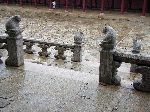
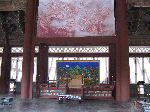

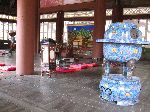 The
interior of Sajeongjeon,
the royal office, Gyeongbokgung, is furnished with the royal throne and royal screen
depicting five mountains (left). To the right are the reading tables, document
boxes and other furniture.
The lower photo features the incense burner, with the throne, lanterns,
candlestick, reading tables and other furniture in the background.
The
interior of Sajeongjeon,
the royal office, Gyeongbokgung, is furnished with the royal throne and royal screen
depicting five mountains (left). To the right are the reading tables, document
boxes and other furniture.
The lower photo features the incense burner, with the throne, lanterns,
candlestick, reading tables and other furniture in the background.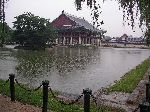
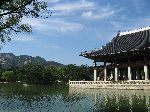 Gyeonghoeru pavillion is where official
banquets were held and foreign envoys were entertained. King Taejong dug
the pond and the pavillion was built in 1412.
Gyeonghoeru pavillion is where official
banquets were held and foreign envoys were entertained. King Taejong dug
the pond and the pavillion was built in 1412.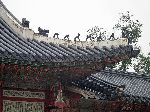
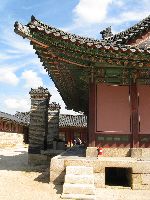
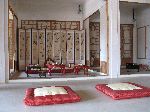
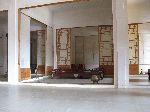 Sajeongjeon
was used as the King's office along with Manchunjeon to the east and
Cheonchujeon to the west -- yin and yang. One was for winter meetings (ondol
heated floor) and one for summer meetings.
Sajeongjeon
was used as the King's office along with Manchunjeon to the east and
Cheonchujeon to the west -- yin and yang. One was for winter meetings (ondol
heated floor) and one for summer meetings.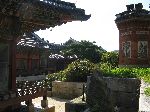
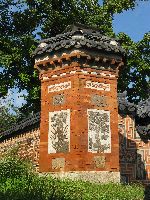
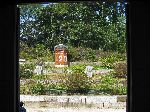 Gyotaejeon,
the queen's residence building has a wooden floor hall in the center, with ondol rooms on each side of it. The present building was restored in 1994.
The queen could look out of the window in the back the building onto a garden: There are four terraces in the garden, one for
each season. The chimneys are part of the traditional ondol heating system for
the buildings. The orange brick is for women.
Gyotaejeon,
the queen's residence building has a wooden floor hall in the center, with ondol rooms on each side of it. The present building was restored in 1994.
The queen could look out of the window in the back the building onto a garden: There are four terraces in the garden, one for
each season. The chimneys are part of the traditional ondol heating system for
the buildings. The orange brick is for women.
 Please
contact us if you would like to be added to
Ibike's mailing list or have questions, comments, corrections or criticism. (Also, please let us know how you learned about us and
found this site.) Privacy policy.
Please
contact us if you would like to be added to
Ibike's mailing list or have questions, comments, corrections or criticism. (Also, please let us know how you learned about us and
found this site.) Privacy policy.
![]() IBF Homepage
IBF Homepage ![]() Ibike Programs
Ibike Programs
![]() Ibike Schedule
Ibike Schedule
![]() Search
Search




